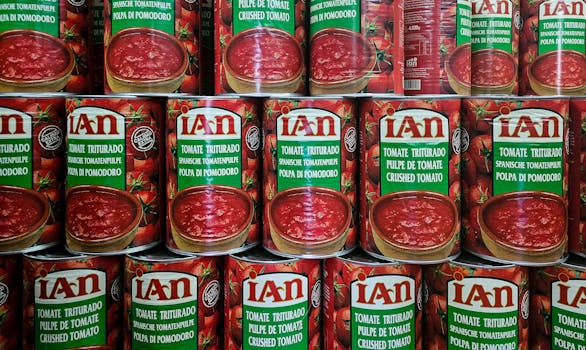Household Economy
Affordable Meal Planning for Busy Families: Simple Strategies for Every Week
Busy weeknights don't have to mean expensive meals. Use our affordable meal planning guide for step-by-step routines, easy recipes, and time-saving kitchen tips every family can use for stress-free dinners.
Advertisement
Life moves fast, and feeding your family well shouldn’t feel impossible. Between after-school activities and long workdays, getting dinner on the table stays high on the priorities—and challenges—list. Discovering affordable meal planning solutions can be a relief for any family’s routine.
Grocery costs keep changing, influencing choices and routines in countless homes. Families want healthy, filling meals without blowing their budgets. Planning not only saves money, but also cuts down kitchen stress and weekday indecision.
This guide walks through affordable meal planning with actionable tips, realistic examples, and practical checklists. It covers tools, process steps, budget mindset, and creative tricks that can work for any family. Let’s dig in together and simplify your weekly meals.
Start with a Weekly Blueprint for Predictable Success
When you decide what you’ll eat ahead of time, dinner stress drops and your grocery bills shrink. Setting a plan gives structure to your week and avoids those last-minute takeout runs.
Try building a simple chart on Sunday, noting dinners for each day. Let your family suggest favorites, but also rotate in new, budget-friendly recipes. This structure keeps everyone fed and your wallet happy.
Build the Menu with Real-Life Favorites
Pick five core meals your family will truly eat. On a blank page, jot down dishes like taco night, pasta bake, sheet pan chicken, veggie stir-fry, or soup with rolls.
Use words your family actually says: try “Let’s do grilled cheese Tuesday” or “Pizza night on Friday”. This builds buy-in and sets clear expectations for every night of the week.
Add two flexible nights: leftovers and “clean out the fridge.” These slots become your buffer. When you script it this way, you’ll waste less food and enjoy more relaxed evenings.
Shop Smart and Stick to the Plan
Look at your menu and create a matching grocery list. Organize it by store section—produce, dairy, pantry—to speed up shopping trips and avoid forgotten ingredients.
Use a simple script: “We need broccoli for stir-fry Tuesday.” If you notice you’re out of a staple, circle it and keep that list handy for quick updates each week.
Praise yourself or family members for sticking to the list: “Nice job skipping those snacks and sticking to our plan!” These micro-celebrations build better habits around affordable meal planning.
| Day | Meal | Main Ingredients | Budget Tip |
|---|---|---|---|
| Monday | Taco Night | Ground turkey, tortillas, beans | Substitute turkey for beef to save money |
| Tuesday | Pasta Bake | Pasta, tomato sauce, veggies | Use frozen vegetables for cost savings |
| Wednesday | Stir-Fry | Rice, mixed veggies, eggs | Make it meatless for protein on a budget |
| Thursday | Soup Night | Broth, beans, leftover veggies | Turn leftovers into a creative soup |
| Friday | Pizza | Pita bread, cheese, sauce | DIY pizzas are less than delivery |
Choose Smart Shopping Habits to Stretch Every Dollar
Consistent, budget-focused grocery habits make affordable meal planning work long-term. When you shop intentionally, you’ll buy exactly what you need and nothing more.
Before heading to the store, scan your pantry and fridge. Keep your list tight—no extras sneaking in. Regular practice builds this into muscle memory.
Stock Your Pantry with Basics for Flexibility
Fill your cupboards with staples like rice, pasta, canned beans, and broth. These items make last-minute meals possible without a run to the store.
Add grains, oats, and peanut butter to round out your collection. Routine items become the backbone of both quick breakfasts and hearty dinners for the week.
- Buy in bulk: Warehouse stores or sale aisles let you buy bigger packages on discount—which means less per meal over time and fewer trips needed.
- Choose store brands: Compare ingredient lists—store-label pantry basics usually match name brands and cost much less.
- Rotate your stock: Use a “first in, first out” approach so nothing expires or goes stale, reducing expensive waste.
- Include ready-to-use frozen veggies: These keep longer, cost less than fresh when out of season, and go right in the pan even on rushed nights.
- Limit processed snacks: Shorter ingredient lists usually mean lower prices and more versatile options you can use across several meals.
This pantry foundation backs up your menu blueprint, reducing moments when you feel stuck or tempted to order out.
Use Deal Timing and Price Comparisons
Check weekly grocery flyers online or by the entrance for current deals. Make a quick side-by-side—if chicken breasts and thighs are both on sale, choose the better per-pound price.
Browse apps or basic comparison stickers on the shelf for staples like rice or eggs. Swapping brands, even once or twice a trip, lowers your total bill without changing what you eat.
- Plan Meatless Nights: Reduce weekly grocery cost by swapping in beans, eggs, or lentils instead of chicken or beef at least one night.
- Shop Seasonally: Choose in-season fruits and vegetables. They taste better and sell for less because of local abundance.
- Compare Per-Unit Prices: Lower per-ounce cost usually saves more than buying smaller, convenient packages every time.
- Batch Cook: Prepare double portions and reuse leftovers in new meals a day or two later to stretch both ingredients and effort.
- Freeze Surplus: Store sale items like bread or cheese in the freezer to capitalize on savings, then thaw as needed during busy weeks.
Every dollar saved stacks up across a month, leading to a real difference come bill time—helping affordable meal planning succeed week after week.
Streamline Cooking with Routine-Friendly Strategies
Having a repeatable kitchen routine makes dinnertime easier, even on the most hectic of evenings. Showing your family the pattern helps everyone jump in and help.
Consider pairing meal types with days. For example, declare “Slow Cooker Monday” and “Breakfast for Dinner Thursday” to standardize planning while keeping things interesting.
Batch Cooking Without Overwhelm
Prepare double or triple batches of recipes you love. For example, make two pans of lasagna and freeze one for later. This saves time without the burnout that comes from prepping many meals in a day.
Turn big batches into mix-and-match lunches. Slice cooked chicken for salads and wraps, or add roasted veggies to quick grain bowls all week.
When cooking, keep it manageable. Start with one new bulk recipe each month instead of changing your whole approach at once.
Prep Ingredients for Faster Weekdays
On Sunday night, chop veggies and portion snacks into bags. Store these in a designated fridge bin with a sticky note: “Grab me first!”
Brown ground meat and store in freezer bags for tacos or pasta. You can even cook grains ahead and freeze flat for quick reheating later.
Assign tasks: One person preps produce while another mixes sauces, even small hands can help with basic rinsing or unloading the dishwasher.
Use Theme Nights and Simple Recipes to Avoid Burnout
Theme nights spark excitement and reduce decision fatigue. Each week, your family knows exactly what type of meal to expect, making menu planning feel like a fun habit instead of a chore.
Try alliteration to make it memorable: “Meatless Monday” or “Taco Tuesday”. These themes help balance your diet and inspire the kids to get involved in picking new ideas.
Repeat Favorites without Boredom
Don’t ditch family favorites just because you had them last week. Add a small twist, like changing the pasta shape or swapping in a new sauce, to keep things fresh on the plate.
Pasta night could use rotini one week and penne the next. Tweak burger toppings: try avocado or salsa instead of ketchup for a new twist without changing your core plan.
Even sides can rotate—switch roasted broccoli for green beans or carrot sticks. Everyone gets the routine comfort, plus just enough change to keep meals lively.
Quick-Cook Recipes on Standby
Keep a binder or app of ten go-to, speedy recipes—dishes you can shop for with your eyes closed. Examples: five-ingredient chili, chicken sheet-pan dinners, black bean quesadillas.
Encourage the family to try a “chef’s choice” night. Someone picks a recipe from the binder, gives it a shot, then rates it. Success earns it a spot on future menus.
Tangibly, share the list on the fridge or in a group chat to get everyone suggesting their picks before grocery day. This boosts buy-in and takes some planning load off your shoulders.
Keep Kids Engaged and Help Them Build Kitchen Confidence
Teaching children practical food prep skills lightens your load and builds positive attitudes toward meals. The earlier you involve kids, the sooner they’ll help with affordable meal planning.
Even small children can wash fruit, stir batter, or pass you items. For bigger tasks, let older kids read recipes aloud, assemble sandwiches, or set timers.
Roles by Age and Stage
Give toddlers soft veggies to rinse. Preschoolers can stir pancake batter and sprinkle cheese. School-aged kids can carefully chop soft produce or assemble kebabs for sheet pan dinners.
As confidence grows, assign more complex steps: Middle schoolers handle stovetop eggs or pancakes, high schoolers plan a dinner start to finish every few weeks.
This shared responsibility makes mealtime a fun, group conversation and builds a lifelong skillset in even your youngest helpers.
Keep the Mood Positive with Stepwise Praise
Say things like, “Great job stirring!” or “Thanks for stacking those veggies.” Encourage trial and error, even if it feels messier than doing it yourself. Focus on effort and learning, not perfection in the kitchen.
Show your own learning mindset: If a new recipe flops, say, “Next time, we’ll add more salt.” This attitude invites kids to experiment and discover affordable meal planning is an ongoing process, not a win-or-fail mission.
Recognize teamwork with family rewards—a movie night or extra story—for following the plan together all week. Positive feedback keeps everyone motivated to participate again.
Rethink Leftovers as Building Blocks for New Meals
Leftovers aren’t just reheated food—they can become the foundation for completely new dishes without extra shopping. By planning for leftovers, affordable meal planning feels seamless instead of repetitive.
Writing a “planned-over” item on your menu each week helps reduce waste and adds variety. Tonight’s chicken can reappear tomorrow in a sandwich, wrap, or soup.
Turn Extras Into Mix-and-Match Bowls
Set up a “bowl bar” midweek: Rice, roasted veggies, last night’s protein, and several sauces on the side. Everyone customizes their own meal, using up what’s on hand.
Add salad greens or tortillas for more variations. This method ensures nothing goes to waste and dinner feels fun, not like eating leftovers again.
Even kids can create combos and name their bowl creations—”Rainbow Power Bowl,” for example. The more ownership, the less resistance at the table.
Soup and Casserole Upgrades
Leftover cooked meats and veggies get a makeover in Friday’s soup or next day’s casserole. Mix with broth, grains, or cheese for comfort that saves time and money without extra planning.
On cool nights, serve with simple toast or a salad for a refrigerator “clean-out” meal. Each person gets a scoop of everything, and the variation keeps it interesting.
Use this script: “Let’s see what delicious creation we can make from last night’s roast.” Framing it this way invites curiosity, not complaints.
Reflect, Adjust, and Keep Affordable Meal Planning Sustainable
Every family’s rhythms and tastes change with time. Keeping an open mind helps affordable meal planning evolve to fit everyone’s needs and avoid burnout.
At the end of each week, gather for a five-minute “what worked?” rundown. Each person offers feedback: favorite meals, which plans felt easy, what could improve. Quick notes keep your system fresh.
Rotate in new recipes every month to prevent menu fatigue. Try a swap night with another family—trade one meal and recipes, inspiring both groups and deepening your culinary toolbox in a budget-friendly way.
Frequently Asked Questions
What’s the biggest money-saving tip for affordable meal planning?
Sticking to a planned grocery list is key. Combining weekly meal planning with an intentional list cuts impulse buys and food waste, maximizing every dollar spent.
How can I make affordable meal planning exciting for kids?
Involve children in meal selection, prep, or even picking a theme night. This keeps them interested, and lets you sneak in new foods without battles.
How do I handle picky eaters on a budget?
Picky eaters thrive on repetition. Serve a mix of favorites with one small new side every week. Gradual changes encourage trying new foods without extra expense.
Can I really save time with affordable meal planning?
Yes! Prepping just one key ingredient or double-batch recipe each week trims cooking and cleanup while keeping meal routines predictable.
Is affordable meal planning realistic for irregular schedules?
It’s doable—flexible “planned-over” meals and a stocked pantry allow for last-minute swaps if activities run late or plans change without creating stress or extra spending.





